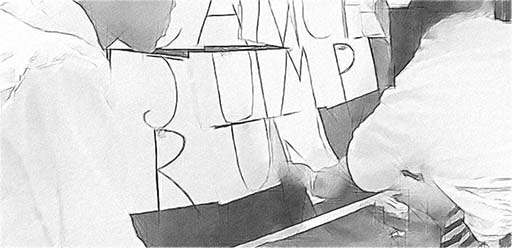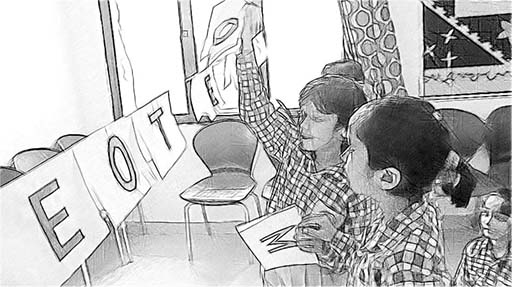2 Letters, sounds and words in the classroom
Case Study 2: Nanda uses the textbook and flash cards
Nanda teaches Class II
I made a set of English letter cards (Figure 1). These cards have all the letters of the English alphabet and also some letter combinations such as ‘ch’, ‘sh’, ‘ph’ and ‘th’. It didn’t take long to make these cards and they always are useful.

I take the textbook lesson and I make another set of flash cards for the key vocabulary in the unit. On one side of the cards I write the words, and on the other side I draw pictures – or find some in magazines – of the words (for example, ‘apple’, ‘mango’, ‘banana’, ‘chapati’, ‘fish’).
Before I teach the lesson, I practise saying the words in English myself so that I feel confident to say them. Sometimes I check my pronunciation with a friend who has better English than me.
In class, I hold up the picture cards and say the word for each of the pictures. I tell the students, ‘Repeat after me … mango’. I do this a few times. I then do the activity again, this time stressing the first sound of each of the words when I say it; for example, ‘m – mango’. I try to ask students short questions using the words, so they can hear them repeated in a sentence. I ask, for example, ‘Do you like mango?’ – and they can answer yes or no.
Then I show students the letter cards and have them practise pronouncing the sounds such as ‘a’, ‘m’, ‘b’, ‘ch’ and ‘f’ when I hold up the cards. Finally, I hold up one of the picture cards and ask students to tell me the sound that it starts with. So when I hold up a card with a mango on it, they can say the sound of ‘m’ or the name of the letter ‘m’ – both are correct.
During the week, I rotate small groups of children to play a game with the two sets of flash cards – matching the picture and word cards to the letter cards. I work with a group of children who have difficulty in making the letter/sound connections. [See Resource 2, ‘Using groupwork’, to learn more about how to organise and manage students in groups.]
In these activities I encourage students to read the letters and say the sound of the letters, and to think about the sounds they make. I also have them read and say the whole words. I think it is important to make them think about the meaning of the words and to use these words in short sentences.
Pause for thought
|
Students can be taught to memorise and chant letters and words, especially when lessons are predictable and repetitive. This does not necessarily mean students understand what they are ‘reading’. Nanda’s classroom activities are varied and interactive. She encourages students to participate, and to make guesses, and she does not over-correct them. Nanda does not teach letters and sounds in isolation – she helps students recognise letters and sounds in words that are meaningful to them (such as ‘mango’ and ‘chapati’).
Activity 2: Letters, sounds and words
Now go to Resource 3. Read through these games and activities. Choose one activity to try out with your class, either from Resource 3 or from Case Studies 1 and 2 above.
Discuss your choice with a colleague if possible. Will you adapt the game or activity in some way, to suit the needs of your class?
Link the activity to the vocabulary in the textbook lesson you are teaching. Try out the activity with a colleague before you do it with students.
The main aim of these activities is to teach letters and sounds, but it is also important to make sure that the students relate these sounds to English words and that they understand the meaning of these words. How will you ensure this?
Do your chosen activity with students. Afterwards, think about what went well, and what you could do differently next time.

It is a good idea to monitor students’ progress in learning English letters and sounds over time, and how they apply their letter/sound knowledge to their reading and writing. A simple tick list or table can help you keep track of individual student’s progress, so you can build their records of achievement:
- Can recite the alphabet.
- Can recognise letters.
- Can recognise letters not in alphabetical order.
- Can link letter names to sounds.
- Can link letter patterns to sounds (e.g. ‘ch’, ‘sh’, ‘th’).
- Can use letter/sound knowledge to read simple words.
- Can use letter/sound knowledge to write simple words.
- Can read words on flash cards.
- Can read words in a sentence.
1 English pronunciation
